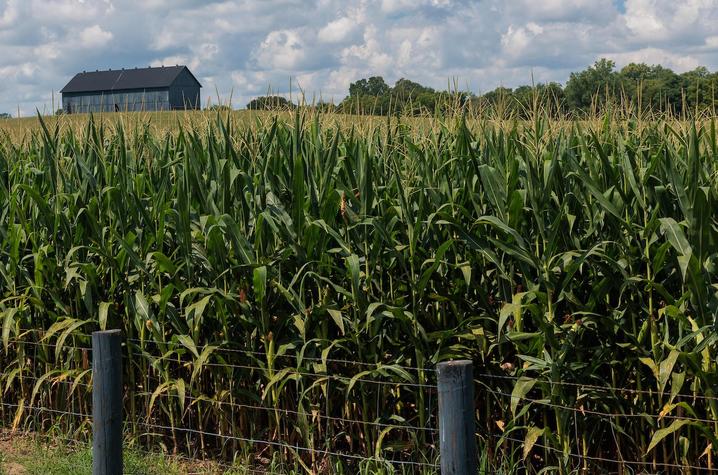UK research collaboration links key corn protein to stronger, longer-lasting seed

LEXINGTON, Ky. (Nov. 18, 2025) — A new international study co-led by the University of Kentucky Martin-Gatton College of Agriculture, Food and Environment (CAFE) shows how a single genetic change helps protect corn seeds during storage. This offers plant breeders a clear target for developing varieties that stay vigorous longer and waste fewer seeds.
The research, published in The Plant Cell, focuses on a damaged protein repair enzyme called ZmPIMT1. The study showed how natural changes in the regulatory region of the gene encoding the enzyme — the DNA “on/off” region that controls how much of the enzyme’s RNA, and then protein, is made — affect seed aging tolerance in corn.
The team found that some corn lines carry a version of this region that turns ZmPIMT1 on more strongly, helping seeds better survive the stress of long-term storage and harsh conditions.
For Bruce Downie, professor in the Department of Horticulture at Martin-Gatton CAFE and a leading member of UK’s seed biology group, the work speaks directly to a simple reality: modern life runs on seeds.
“Roughly 70% of the human diet comes directly from seeds, and much of the rest depends on animals fed on seeds,” Downie said. “We eat them, wear them as cotton, ferment them into beverages and fuel. If seed lots fail, the costs hit farmers, companies and consumers all the way down the line.”
The study, conducted in part with professor Tianyong Zhao at Northwest A&F University in China and professor Yumin Zhang, who is Zhao’s associate, identifies two main versions of the ZmPIMT1 regulatory region across diverse corn lines. One version drives high levels of ZmPIMT1 mRNA production, while another carries a large DNA insertion that lowers expression and, consequently, weakens seed performance under aging stress. Seeds with more ZmPIMT1 protein kept higher germination percentages and produced healthier seedlings after accelerated aging tests, a standard measure of seed storability.
The ZmPIMT1 cellular repair crew
Over time, normal chemical reactions twist and damage proteins inside dry seeds, including proteins needed as soon as the seed takes up water and starts to germinate — the period in which the plant starts to grow again after being quiescent. Instead of discarding those damaged proteins and rebuilding them from scratch, ZmPIMT1 helps flip faulty pieces back into working shape. That saves energy and keeps critical systems running during the first hours of germination.
ZmPIMT1 is a “repair helper” in seeds that watches over a protein called PABP2, which helps choose which stored messages get turned into new proteins when a seed wakes up and takes in water. If PABP2 is damaged and not fixed, the seed can’t make important proteins fast, so it loses vigor. When a seed has more ZmPIMT1, PABP2 works better, and the seed can handle aging and still sprout strong.
“This reinforces what seed biologists call ‘Job’s rule,’” Downie said. “If you want a seed to survive dry storage, you must protect and repair the machinery of protein synthesis. This work shows that in corn, ZmPIMT1 is a major part of that protection.”
To study the importance of ZmPIMT1, the researchers used multiple approaches. Corn lines with reduced ZmPIMT1 showed poorer performance after aging. Lines with elevated ZmPIMT1 held up better in harsh storage tests.
Downie says the findings can give breeders and seed companies a concrete genetic marker to track as they strive to breed ever more resilient seeds.
“Seed producers invest heavily to deliver hybrids that farmers trust,” Downie said. “If a batch loses vigor in storage, that means lost germination percentages, replanting costs and is frustrating for farmers. Choosing lines with the stronger ZmPIMT1 promoter is a practical step toward seed lots that stay reliable.”
The study also highlights the strength of the cross-disciplinary group of scientists from Martin-Gatton CAFE and the College of Arts and Sciences that make up UK’s seed biology group. They study how seeds develop, survive drying, resist damage and complete germination to produce new plants — work that connects molecular biology to food security, conservation and agricultural resilience.
“Many people never think about what keeps a seed alive from harvest to planting,” Downie said. “Our group does, every day. This collaboration shows how basic science at the cellular level can point directly to tools that support farmers and safeguard the food supply.”
To learn more about the seed biology group, visit https://seedbiology.mgcafe.uky.edu/.
This material is based upon work that is supported by the National Institute of Food and Agriculture, U.S. Department of Agriculture, Hatch Project under award number 1019088. Any opinions, findings, conclusions or recommendations expressed in this publication are those of the author(s) and do not necessarily reflect the view of the Department of Agriculture.
As the state’s flagship, land-grant institution, the University of Kentucky exists to advance the Commonwealth. We do that by preparing the next generation of leaders — placing students at the heart of everything we do — and transforming the lives of Kentuckians through education, research and creative work, service and health care. We pride ourselves on being a catalyst for breakthroughs and a force for healing, a place where ingenuity unfolds. It's all made possible by our people — visionaries, disruptors and pioneers — who make up 200 academic programs, a $476.5 million research and development enterprise and a world-class medical center, all on one campus.




